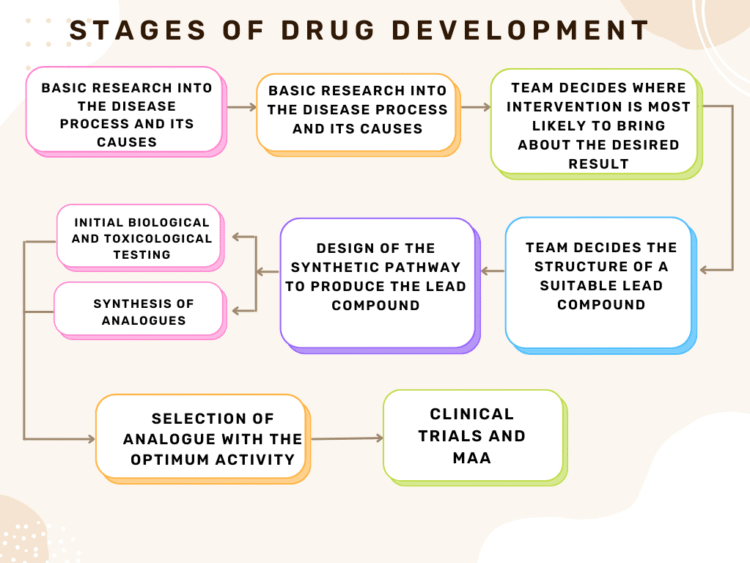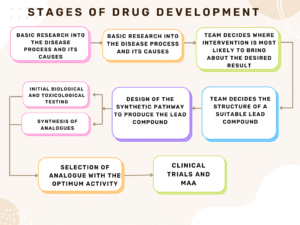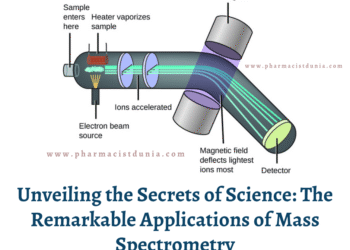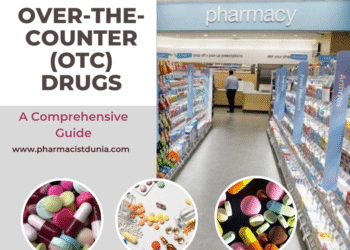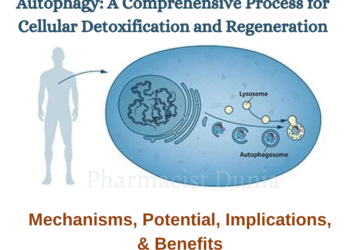Drug Design:
Drug Design is a process that involves modifying a lead compound to create a new drug with improved efficacy, safety, and specificity. The lead compound, obtained through random screening, serves as a starting point for further molecular modification. For example, Sulfanilamide is a successful lead compound that has been used to develop antimalarials, antidiabetics, anti-thyroids, and diuretics.
Once a modified compound is created, it goes through drug development, a multi-disciplinary process that involves teams of researchers, scientists, and regulatory experts. Drug development includes preclinical testing, clinical trials, and regulatory approval. During preclinical testing, the modified compound is tested for safety and efficacy in animal models. Clinical trials, which are typically conducted in three phases, test the drug’s safety, dosage, and efficacy in larger groups of patients. If the drug successfully completes the clinical trial process, it can be submitted for regulatory approval. Once approved, the drug can be marketed and sold to patients.
Some suggested SEO-friendly keywords to include in this content are: drug design, lead compound, molecular modification, sulfanilamide, antimalarials, antidiabetics, anti-thyroids, diuretics, drug development, preclinical testing, clinical trials, regulatory approval, efficacy, safety, and specificity.
Drug design, also known as rational drug design or computer-aided drug design (CADD), is the process of discovering and designing new drugs by using computer simulations and experimental methods. The aim of drug design is to create new compounds that can effectively interact with specific drug targets such as proteins, enzymes, or receptors in the human body, and ultimately, treat or prevent diseases.
Drug design can involve a variety of techniques, including molecular docking, molecular dynamics simulations, and virtual screening, among others. It often starts with the identification of a drug target, followed by the design and synthesis of compounds that can interact with the target. These compounds are then tested in vitro and in vivo to evaluate their efficacy and safety.
Examples of drugs that were designed using these techniques include:
– Protease inhibitors used to treat HIV, such as ritonavir and lopinavir
– Imatinib, a tyrosine kinase inhibitor used to treat chronic myeloid leukemia and gastrointestinal stromal tumors
– Tamiflu, an antiviral drug used to treat influenza
– Enfuvirtide, a fusion inhibitor used to treat HIV
– Voriconazole, an antifungal drug used to treat fungal infections
These are just a few examples of drugs that were designed using a rational drug design approach. There are many other examples of drugs that have been developed through this process, and drug design continues to be an important field in the discovery of new therapeutics.
Lead Compound:
A lead compound is a compound with specific biological activity obtained from natural or synthetic sources. A lead compound is obtained by random screening. Molecular modification of a lead compound makes into drug. As a result, Salfanilamide is a lead compound, molecular modification of this drug produce
-antimalarials (e.g. Salfa drugs)
-antidiabetes (e.g. Sulphonyl urea)
-anti thyroids (e.g. methimazole)
-diuretics (e.g. thiazides)
A lead compound is a chemical compound that exhibits specific biological activity and serves as a starting point for the development of new drugs. Lead compounds are typically identified through a process called high-throughput screening (HTS), which involves testing large libraries of compounds for their ability to interact with specific drug targets or produce a desired biological effect.
Lead compounds can be obtained from various sources, including natural products, synthetic compounds, and existing drugs. They often require further optimization through chemical modification to improve their potency, selectivity, and safety before they can be developed into drugs.
The molecular structure of a lead compound can be modified through a process called medicinal chemistry or rational drug design, which involves making changes to its chemical structure to improve its pharmacological properties. This process often involves the use of computational tools, such as molecular modeling and simulation, to predict how changes to the chemical structure of the lead compound will affect its activity and to design new compounds with improved pharmacokinetic and pharmacodynamic properties.
Once a lead compound has been optimized and developed into a drug candidate, it undergoes preclinical testing to evaluate its efficacy and safety in animals, followed by clinical trials in humans to determine its safety and efficacy in a larger population. Therefore, lead compounds play a crucial role in the drug discovery and development process, and they are essential for the development of new drugs to treat a wide range of diseases and conditions.
Molecular modification, also known as chemical modification or molecular optimization, refers to the process of changing the chemical structure of a molecule, typically a lead compound, to improve its properties or to develop a new compound with desired properties. In drug discovery and development, molecular modification is an essential step in the drug design process, as it allows researchers to optimize lead compounds and improve their pharmacokinetic and pharmacodynamic properties.
Molecular modification can involve various types of changes to the chemical structure of a molecule, including adding or removing functional groups, modifying the size and shape of the molecule, or altering its stereochemistry. The goal of molecular modification is to improve the compound’s binding affinity to its target, increase its potency, reduce its toxicity, or improve its selectivity for a specific target or tissue.
Molecular modification is typically done through a combination of experimental and computational techniques. Computational techniques such as molecular modeling, virtual screening, and QSAR (Quantitative Structure-Activity Relationship) analysis can be used to predict how changes to the molecular structure will affect the compound’s activity and selectivity. Experimental techniques such as synthesis, purification, and biological assays are then used to synthesize and test the modified compounds in vitro and in vivo.
Overall, molecular modification is a critical step in drug design, as it allows researchers to optimize lead compounds and develop new compounds with improved pharmacological properties that can be further developed into safe and effective drugs for the treatment of various diseases and conditions.
Drug Development:
Drug Development is the conversion of biologically active compound into a safe marketable product. It is a multi disciplinary process that requires the collaboration of teams of workers from many different disciplines. Its success is dependant on their skills and judgements.
Drug development is the process of bringing a new drug from the initial discovery stage through preclinical testing, clinical trials, and regulatory approval to become a marketable product. Drug development involves various stages, including drug discovery, preclinical testing, clinical trials, regulatory approval, and post-marketing surveillance.
Drug discovery is the initial stage of drug development, where lead compounds are identified and optimized through molecular modification. Preclinical testing follows drug discovery and involves the evaluation of the safety and efficacy of drug candidates in vitro and in vivo studies. The results of these studies are used to determine whether a drug candidate is safe and effective enough to proceed to clinical trials.
Clinical trials are the next stage of drug development, which involves testing the safety and efficacy of drug candidates in humans. Clinical trials are conducted in three phases, starting with a small group of healthy volunteers in phase 1, followed by a larger group of patients with the target disease in phase 2, and finally, a large-scale trial in phase 3 to confirm the safety and efficacy of the drug in a broader patient population.
Regulatory approval is the final stage of drug development, which involves submitting a New Drug Application (NDA) to regulatory authorities, such as the US Food and Drug Administration (FDA), for approval to market the drug. The regulatory authorities evaluate the safety and efficacy of the drug based on the results of preclinical and clinical studies, and approve the drug for marketing if it meets their standards.
Examples of successful drugs that have gone through the drug development process include:
– Lipitor: a cholesterol-lowering drug that was discovered in the 1980s and went through preclinical testing and clinical trials before being approved by the FDA in 1996.
– Herceptin: a targeted therapy for breast cancer that was discovered in the 1990s and went through preclinical testing, clinical trials, and FDA approval before being launched in 1998.
– Remdesivir: an antiviral drug that was developed in response to the COVID-19 pandemic, which went through preclinical testing, clinical trials, and FDA approval for emergency use in 2020.
Stages of Drug Development:
Drug development is a complex and lengthy process that involves various stages, each with its own unique challenges and requirements. The stages of drug development include:
1. Discovery and Target Identification:
This is the initial stage of drug development, where scientists identify a biological target or pathway that is associated with a specific disease or condition. Targets can be identified through various techniques such as high-throughput screening, genetic analysis, and molecular modeling. Once a target is identified, the search for a lead compound that can interact with the target begins.
Examples of drugs that have gone through this stage of drug development include Imatinib, which was discovered as a treatment for chronic myeloid leukemia by identifying a specific molecular target, and sildenafil, which was discovered by targeting an enzyme involved in the regulation of blood flow.
2. Lead Optimization:
After identifying a lead compound, scientists work to optimize its properties through molecular modification. The goal of this stage is to improve the compound’s pharmacokinetic and pharmacodynamic properties, such as its bioavailability, efficacy, and safety.
Examples of drugs that have gone through this stage of drug development include Aspirin, which was developed through the optimization of Salicylic acid, and Morphine, which was optimized through molecular modification of Opium.
3. Preclinical Testing:
In this stage, the safety and efficacy of the lead compound are evaluated in vitro and in vivo studies using animal models. Preclinical testing is done to determine the safety profile of the compound, its pharmacokinetics, and its potential for toxicity.
Examples of drugs that have gone through this stage of drug development include Tamoxifen, which underwent preclinical testing before being approved for use in breast cancer, and Omeprazole, which was tested in animal models before being approved for use as an acid reducer.
4. Clinical Trials:
Clinical trials are the most critical stage of drug development, involving human testing of the drug candidate. Clinical trials are divided into three phases, with each phase designed to answer specific questions about the drug’s safety, efficacy, and dosage.
Examples of drugs that have gone through this stage of drug development include Fluoxetine, which underwent clinical trials before being approved for use as an antidepressant, and Sofosbuvir, which was tested in clinical trials before being approved for use in treating Hepatitis C.
5. Regulatory Approval:
After completing clinical trials, the drug developer submits a New Drug Application (NDA) to regulatory agencies such as the US FDA. The regulatory agency evaluates the safety and efficacy of the drug candidate and approves it for marketing if it meets their standards.
Examples of drugs that have gone through this stage of drug development include Lisdexamfetamine, which received FDA approval for treating Attention Deficit Hyperactivity Disorder (ADHD) after completing clinical trials, and Adalimumab, which underwent regulatory approval before being marketed as a treatment for Rheumatoid Arthritis.
6. Post-Marketing Surveillance:
Even after a drug is approved, post-marketing surveillance continues to monitor its safety and efficacy. Post-marketing surveillance involves ongoing monitoring of adverse events and side effects of the drug, as well as monitoring for drug interactions and long-term effects.
Examples of drugs that are currently undergoing post-marketing surveillance include Remdesivir, which is being monitored for its effectiveness in treating COVID-19 patients, and Bupropion, which is being monitored for its effectiveness in treating depression.
References:
1. DiMasi, J. A., Feldman, L., Seckler, A., & Wilson, A. (2010). Trends in risks associated with new drug development: success rates for investigational drugs. Clinical pharmacology and therapeutics, 87(3), 272-277.
2. Kola, I., & Landis, J. (2004). Can the pharmaceutical industry reduce attrition rates?. Nature reviews Drug discovery, 3(8), 711-715.
3. Pammolli, F., Magazzini, L., & Riccaboni, M. (2011). The productivity crisis in pharmaceutical R&D. Nature reviews Drug discovery, 10(6), 428-438.
4. Zerhouni, E. (2005). Medicine. The NIH roadmap. Science, 310(5746), 745-747.
5. FDA, Guidance for Industry: Development and Approval of Combination Products, 2004.
6. FDA, CDER Handbook, 2006.

